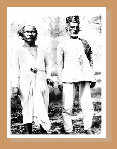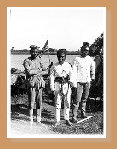DATU PIANG (AMAI MINGKA /AMA NI MINGKA)
1846 ~ 1933
Website source: phil-am-war.org
ARTICLES:
June 13, 1988
Abinales, P. N. Philippine Daily Inquirer. Page 18.
Dec. 25, 1999
Maulana, Nash B. Philippine Daily Inquirer.
May 2, 2004
Maulana, Nash B. Philippine Daily Inquirer.
BIOGRAPHY / REFERENCE BOOKS:
WEBPAGE LINK:
INTERNET PHOTOS:
Website Source: California Academy of Sciences Library - Special Collection.
Dr. William R. Eastman Sr. Collection. These photographs were taken by Dr. William R. Eastman, Sr. in the Philippines
between 1902 and 1906. Dr. Eastman was a captain in the U. S. Army Medical Corps.
Circa: 1904 -1905.
Circa: 1904 -1905.
Cross Reference:
1. Sharif Muhammad Afdal, an Afgan
pandita
who resided in the Cotabato River Valley (where he
was married to the daughter of datu Ali)...
1. Gowing, Peter Gordon (1977). Mandate in Moroland. Page 84.
(includes Moro Datus Piang and Sheerif Afcal).
Circa: 1904 -1905.
Website Source: Medieval Sword Resource Site.
Circa: ___ Photo and Publisher: B. W. Kilburn.
Website Source: Smithsonian Institute Research Information System.
Circa:
Notes:
According to Dr. Grace Piang Trompeta (EdD) the photo was taken at Datu Piang's executive
house in Dulawan, formerly the Sultanate of Buayan. In the early 1950's the place was named
Datu Piang in his honor. The young boy is Gumbay, he is approximately 10 yrs. or younger.
The two men are his brothers and the brasswares are Datu Piang's personal collection. The
photo must have been taken circa 1913 -1915.
Cross Reference:
1. Republic Act No. 1035 - An Act changing the name of the municipality of Dulawan in the Province
of Cotabato to Datu Piang.
Section 1. The name of the Municipality of Dulawan in the Province hereby changed to Datu Piang.
Section 2. This Act shall take effect upon its approval.
Approved: June 12, 1954.
2. His settlement consists of many houses and shops. Among his varied business interests, I heard
most of the manufactory, farther up in the river, where articles of great beauty are made. There
are wonderfully embossed "chow" dishes of metal, used for food, with gayly colored straw covers;
brass gongs of many tones, and some of the finest weapons made in Moro Land -
krises,
and
barongs,
inlaid with gold and silver.
3. Piang was a Chinaman, a friendly enemy, who had a large following of Moros, all well armed.
He had lantakas, or cannon[s] of small calibre, with which to defend his village where they
manufactured arms, casting the lantakas, also brass helmets and brass utensils of various kinds.
1. Chan Robles Virtual Law Library. Philippine Laws, Statutes and Codes.
2. Boyce, William D. (1914). United States Colonies and Dependencies. Page 379.
3. Wooster, Robert (2003). Soldier, Surgeon, Scholar: The Memoirs of William Henry Corbusier,
1844 -1930. Page 143.
Website Source: University of California. Calisphere.
Circa:
Cross Reference:
1. INTERVIEW OF COMMISSION WITH DATO PIANG, COTABATO, APRIL 2, 1901.
PRESIDENT (questions addressed through interpreter). With the permission of Dato Piang,
we will ask him some questions about the Moros here, and their trade and their customs.
PIANG. All right, sir.
Q. Will you first ask him how many people he has under him? - A. He says he can not tell; can
not count them.
Q. Does he think he has 20,000? - A. He said, through this man, that he had 15,000. He says he
can not tell, because all the up-river datos are friendly to him and all their followers are his followers.
Q. I don't mean to separate the datos, but I mean how many Moros are there in the up-river district
here that are friendly to each other and are friendly to the Americans? - A. About 15,000 that have
presented themselves with him.
1. ___ Report of the United States Philippine Commission to the Secretary of War for the period
from December 1, 1900 to October 15, 1901. Part 2. 1901. Page 105.
Circa:
Website Source: University of Michigan Special Collections Library.
Circa:
Website Source: University of Wisconsin - Madison. SouthEast Asian Image & Texts Project.
Circa: 1899 -1901.
Cross Reference:
1. Datu Piang (front row, second from right, with cane) and his officials and attendants, circa
1914. Despite his quite considerable wealth and power, Datu Piang is reported always to
have dressed quite simply, in contrast to the more elaborate attire worn by most Magindanaon
datus of the period. The datu's attendants include two kris bearers, a
kampilan
(long sword)
bearer (second from left, rear), and two men carrying brass containers for betel nut.
Courtesy of the U. S. National Archives.
1. Mckenna, Thomas M. (1952). Muslim Rulers and Rebels. Page 95.
4.
Notes:
Photo may not represent a Moro lantaca but one casted in other parts of the Philippine islands.
Page 1
Page 1
Cross Reference:
1. When Brigadier-General John J. Pershing, the last American Governor of the Moro Province
(1909 -1913) visited Datu Piang at his residence in Dulawan, the
Maliga Walay
had just been
completed. A camera had caught them viewing the red-roofed house, which Brigadier-General
Pershing called, the "executive house."
Today, the
Maliga Walay
has become an archive through the efforts of the late Mayor Datu
Saudi Ampatuan and his son, Mayor Saudi Ampatuan, Jr. whose maternal grandmother is a
daughter of Bai Kayuyo, second daughter of Datu Piang.
1. Piang, Putri Gonong Lidang Grace T. (2007). Once upon a time in Dulawan. Page 38-39.
Datu Piang - Related Photos, Postcards and Prints Collection.
NOTICE: Contains graphic wartime images that may be disturbing for viewers.
campilans






